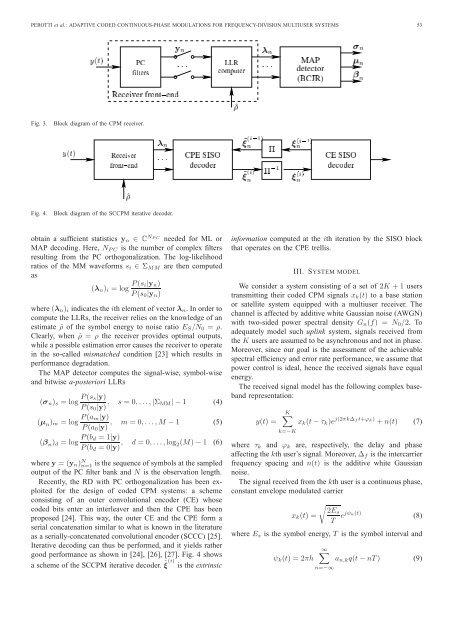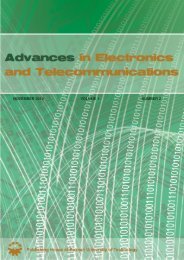channel - Advances in Electronics and Telecommunications
channel - Advances in Electronics and Telecommunications
channel - Advances in Electronics and Telecommunications
You also want an ePaper? Increase the reach of your titles
YUMPU automatically turns print PDFs into web optimized ePapers that Google loves.
PEROTTI et al.: ADAPTIVE CODED CONTINUOUS-PHASE MODULATIONS FOR FREQUENCY-DIVISION MULTIUSER SYSTEMS 53<br />
Fig. 3. Block diagram of the CPM receiver.<br />
Fig. 4. Block diagram of the SCCPM iterative decoder.<br />
obta<strong>in</strong> a sufficient statistics yn ∈ C NP C needed for ML or<br />
MAP decod<strong>in</strong>g. Here, NP C is the number of complex filters<br />
result<strong>in</strong>g from the PC orthogonalization. The log-likelihood<br />
ratios of the MM waveforms si ∈ ΣMM are then computed<br />
as<br />
(λn)i = log<br />
P (si|yn)<br />
P (s0|yn)<br />
where (λn)i <strong>in</strong>dicates the ith element of vector λn. In order to<br />
compute the LLRs, the receiver relies on the knowledge of an<br />
estimate ˆρ of the symbol energy to noise ratio ES/N0 = ρ.<br />
Clearly, when ˆρ = ρ the receiver provides optimal outputs,<br />
while a possible estimation error causes the receiver to operate<br />
<strong>in</strong> the so-called mismatched condition [23] which results <strong>in</strong><br />
performance degradation.<br />
The MAP detector computes the signal-wise, symbol-wise<br />
<strong>and</strong> bitwise a-posteriori LLRs<br />
P (ss|y)<br />
(σn)s = log<br />
P (s0|y) , s = 0, . . . , |ΣMM| − 1 (4)<br />
P (am|y)<br />
(µ n)m = log ,<br />
P (a0|y)<br />
m = 0, . . . , M − 1 (5)<br />
(βn)d = log P (bd = 1|y)<br />
P (bd = 0|y) , d = 0, . . . , log2(M) − 1 (6)<br />
where y = (yn) N n=1 is the sequence of symbols at the sampled<br />
output of the PC filter bank <strong>and</strong> N is the observation length.<br />
Recently, the RD with PC orthogonalization has been exploited<br />
for the design of coded CPM systems: a scheme<br />
consist<strong>in</strong>g of an outer convolutional encoder (CE) whose<br />
coded bits enter an <strong>in</strong>terleaver <strong>and</strong> then the CPE has been<br />
proposed [24]. This way, the outer CE <strong>and</strong> the CPE form a<br />
serial concatenation similar to what is known <strong>in</strong> the literature<br />
as a serially-concatenated convolutional encoder (SCCC) [25].<br />
Iterative decod<strong>in</strong>g can thus be performed, <strong>and</strong> it yields rather<br />
good performance as shown <strong>in</strong> [24], [26], [27]. Fig. 4 shows<br />
a scheme of the SCCPM iterative decoder. ˜ ξ (i) is the extr<strong>in</strong>sic<br />
<strong>in</strong>formation computed at the ith iteration by the SISO block<br />
that operates on the CPE trellis.<br />
III. SYSTEM MODEL<br />
We consider a system consist<strong>in</strong>g of a set of 2K + 1 users<br />
transmitt<strong>in</strong>g their coded CPM signals xk(t) to a base station<br />
or satellite system equipped with a multiuser receiver. The<br />
<strong>channel</strong> is affected by additive white Gaussian noise (AWGN)<br />
with two-sided power spectral density Gn(f) = N0/2. To<br />
adequately model such upl<strong>in</strong>k system, signals received from<br />
the K users are assumed to be asynchronous <strong>and</strong> not <strong>in</strong> phase.<br />
Moreover, s<strong>in</strong>ce our goal is the assessment of the achievable<br />
spectral efficiency <strong>and</strong> error rate performance, we assume that<br />
power control is ideal, hence the received signals have equal<br />
energy.<br />
The received signal model has the follow<strong>in</strong>g complex baseb<strong>and</strong><br />
representation:<br />
y(t) =<br />
K�<br />
k=−K<br />
xk(t − τk)e j(2πk∆f t+ϕk) + n(t) (7)<br />
where τk <strong>and</strong> ϕk are, respectively, the delay <strong>and</strong> phase<br />
affect<strong>in</strong>g the kth user’s signal. Moreover, ∆f is the <strong>in</strong>tercarrier<br />
frequency spac<strong>in</strong>g <strong>and</strong> n(t) is the additive white Gaussian<br />
noise.<br />
The signal received from the kth user is a cont<strong>in</strong>uous phase,<br />
constant envelope modulated carrier<br />
xk(t) =<br />
� 2Es<br />
T ejψk(t)<br />
where Es is the symbol energy, T is the symbol <strong>in</strong>terval <strong>and</strong><br />
ψk(t) = 2πh<br />
∞�<br />
n=−∞<br />
(8)<br />
an,kq(t − nT ) (9)







